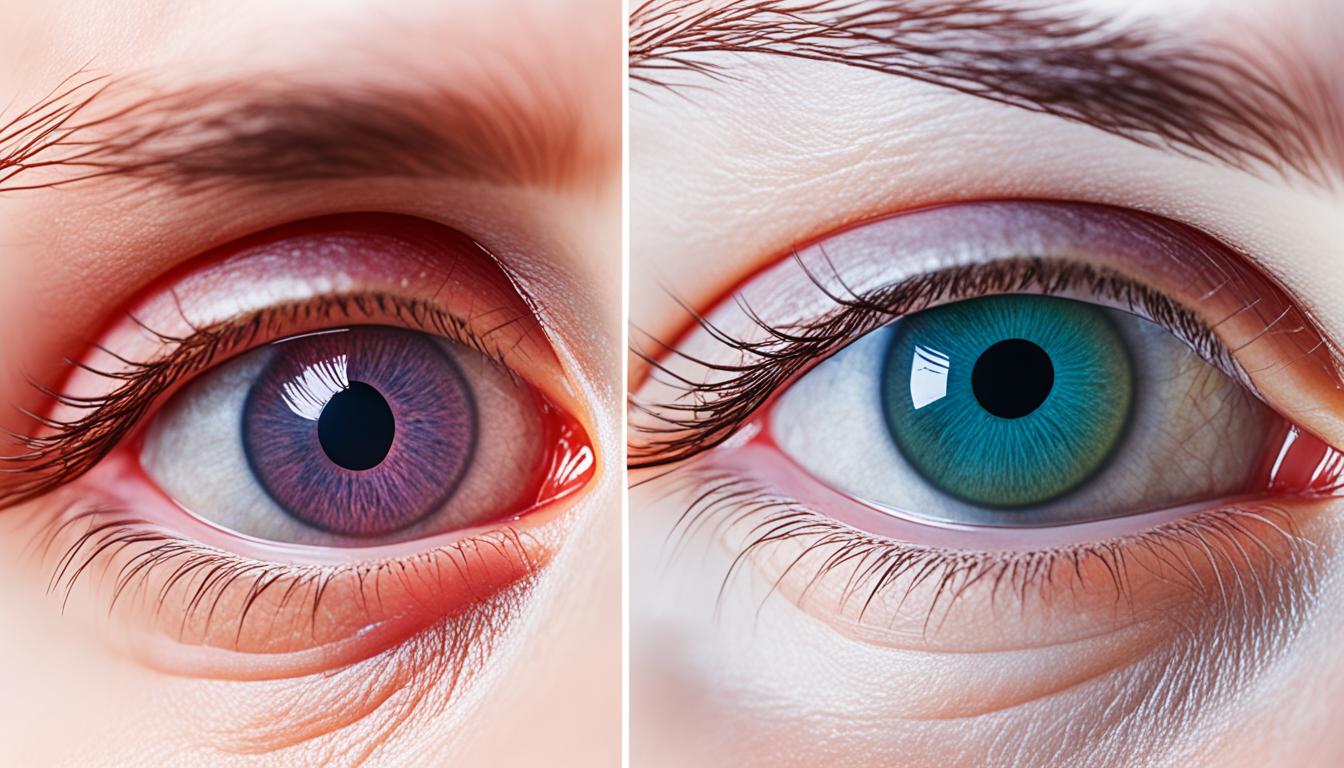Hordeolum, or a stye, is a painful red bump near the eyelids. It’s often tender to the touch. This bump is caused by a blocked oil gland. This problem can occur on the top or bottom eyelids. It may last from a few days to several weeks. Sometimes, it may become a chalazion. A chalazion is a painless bump caused by oil glands in the eyelid getting blocked.
Typical symptoms of a stye are redness, swelling, soreness, itchiness, and watery eyes. Your eye might also feel crusty, and you’ll be sensitive to bright light. Styes are usually caused by gland blockages or bacteria like staphylococcus aureus. Various things can make you more likely to get a stye. These include past stye problems, wearing contacts, old or dirty eye makeup, and some skin diseases or diabetes.
To treat a stye, many recommend warm compresses and keeping your eyes clean. It’s best not to touch the stye or wear eye makeup. Over-the-counter pain meds can help. A doctor might suggest other treatments like cleansers, eye drops, or even a small surgical cut to remove the blockage. To prevent styes, take care of your eyelids and maintain good hygiene. You can also try omega-3 vitamins and limit your eye makeup.
Key Takeaways:
- Hordeolum, or stye, is a common ocular condition characterized by a tender, red bump on the edge of the eyelids.
- Symptoms of a stye include redness, swelling, eye soreness, itchiness, tearing up, and crusting of the eye, and sensitivity to bright light.
- Styes are typically caused by a blockage of the gland or inflammation contributed by bacteria like staphylococcus aureus.
- Treatment options for styes include warm compresses, massaging the stye, keeping the eye area clean, and over-the-counter pain medications.
- Preventative measures for styes include maintaining good skin hygiene on the eyelids and around the eyes, taking omega-3 vitamins, limiting the use of eye makeup, thoroughly washing hands, and periodically applying warm compresses.
Hordeolum (Stye) – Causes and Symptoms
A hordeolum, or stye, is a sudden infection in the eyelid glands. It’s often caused by the bacteria Staphylococcus aureus. This happens when gland secretions are blocked and can’t flow normally.
The result is a painful red lump on the eyelid. Styes can be outside the eyelid or deep inside. They make the eye feel gritty, look red, and the eyelid might swell and hurt a lot.
Styes are more likely if you have certain skin problems, dry eyes, or use old makeup. Other risks include a history of styes, diabetes, and low testosterone. Keeping your eyelashes clean helps avoid styes.
To treat a stye, use warm compresses a few times a day. If it gets worse or very swollen, a doctor might give you antibiotics or drain it surgically. Always clean your eyelashes to stop styes from coming back.
Causes of Hordeolum (Stye)
A stye is often due to a bacterial infection. Staphylococcus aureus is the most common cause. It starts when the glands in your eyelid get clogged. Bacteria then invade these glands, causing them to inflame and form a stye.
Symptoms of Hordeolum (Stye)
A stye usually feels painful and gritty. Your eye might look red and the eyelid can swell. If the swelling is a lot, it can be very painful.
If you have these symptoms, get checked by a doctor. They can provide the right treatment.
Prevention of Hordeolum (Stye)
You can lower your risk of getting a stye by:
- Keeping your eyelids and face clean
- Not using old or shared makeup
- Washing your hands before touching your face
- Keeping your eyelashes tidy
- Not sharing eye-touching personal items
These steps can help you keep your eyes healthy and free from styes.
| Causes of Hordeolum (Stye) | Symptoms of Hordeolum (Stye) |
|---|---|
|
– Bacterial infection – Stasis of gland secretions – Blocked ducts – Staphylococcus aureus bacteria |
– Pain – Granular sensation – Redness – Swelling of eyelid and surrounding skin – Excessive painful swelling |
Conclusion
A stye, also known as hordeolum, is a red, tender bump on the eyelid. It’s caused by a blocked oil gland. Normally, styes go away on their own in a week or two.
To treat a stye at home, use warm compresses and gently massage the area. Keep the eye clean and take over-the-counter pain medicine. If it doesn’t get better, see a doctor. They might use antiseptic sprays or even do a small surgery.
To stop styes from happening, keep your eyelids and eyes clean. Take omega-3 vitamins and go easy on eye makeup. Always wash your hands and use warm compresses from time to time. If a stye lasts more than a few days and feels bad, get help from a doctor.

